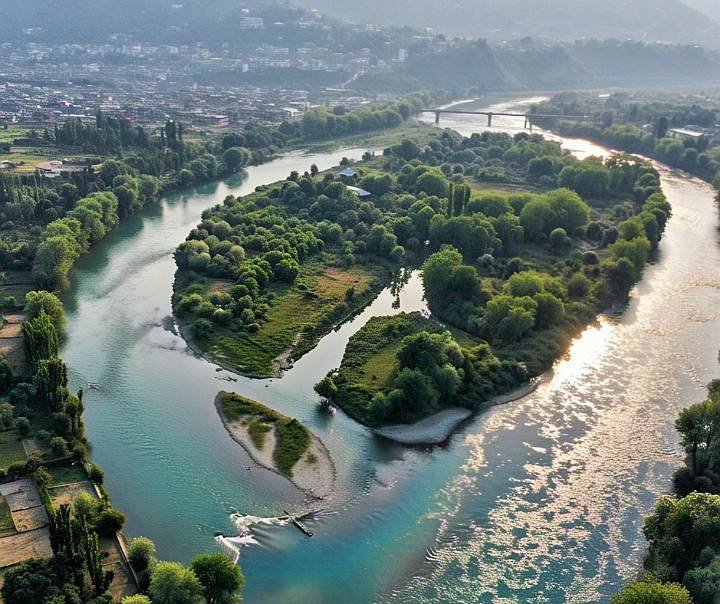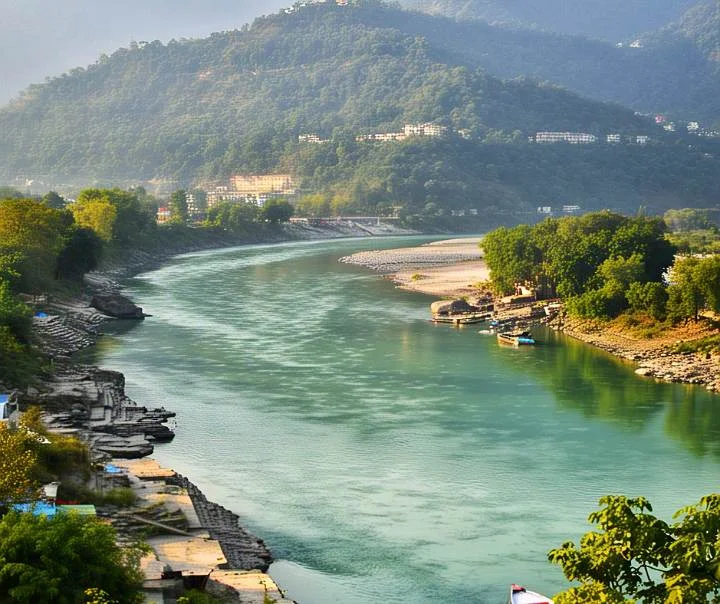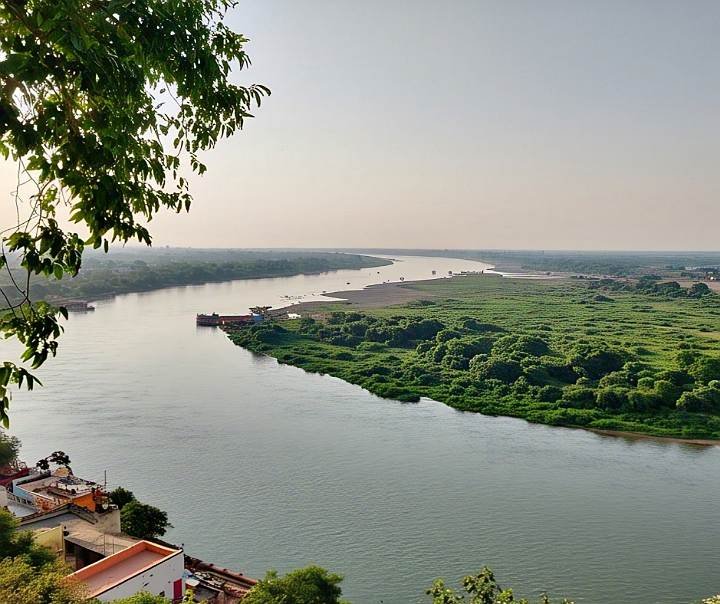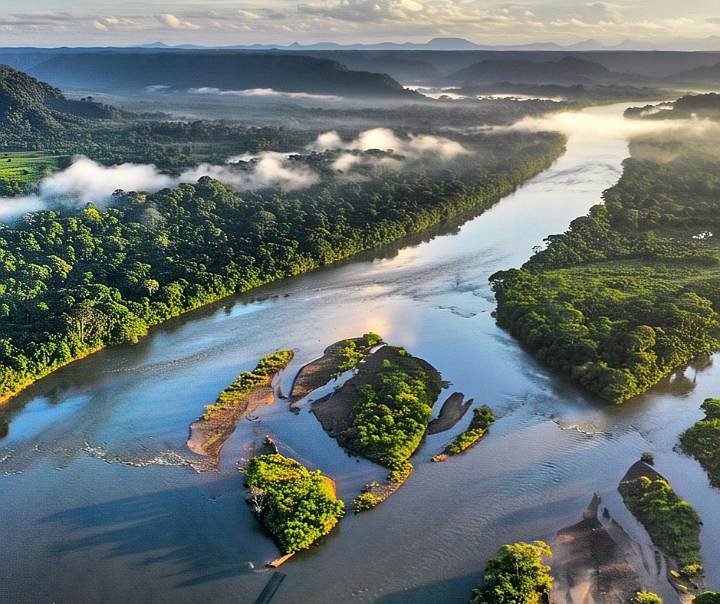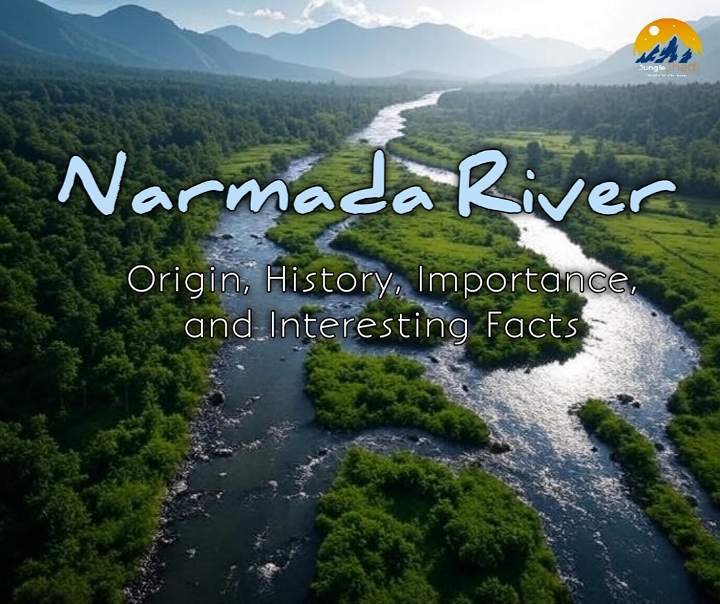Yamuna River : A Comprehensive Journey from Source to Confluence
The Yamuna River is one of India’s most sacred and significant rivers. As the largest tributary of the Ganga River, it serves as a lifeline for several states in northern India. Beyond its role as a water source, the Yamuna is deeply intertwined with India’s culture, religion, and history. In this detailed post, we will explore the Yamuna River’s entire journey—from its origin to its confluence with the Ganga—along with its tributaries, religious and cultural significance, environmental challenges, and other key aspects.
Introduction to the Yamuna River
The Yamuna River, also known as Jamuna or Kalindi in certain regions, is India’s second-largest tributary of the Ganga River. Originating from the Yamunotri Glacier in the Himalayas of Uttarakhand, it travels 1,376 kilometers before merging with the Ganga at the Triveni Sangam in Prayagraj, Uttar Pradesh. The Yamuna’s catchment area spans 366,223 square kilometers, accounting for 40.2% of the Ganga Basin.
Flowing through states like Uttarakhand, Himachal Pradesh, Haryana, Delhi, and Uttar Pradesh, the Yamuna is vital for agriculture, drinking water, and industry. It is also deeply revered in Hinduism, where it is worshipped as Goddess Yamuna, the daughter of the Sun God and sister of Yama, the God of Death. According to Hindu beliefs, bathing in the Yamuna’s sacred waters liberates one from the fear of death.
The river’s significance extends beyond religion and culture to economics and the environment. It supports the water needs of approximately 57 million people and meets over 70% of Delhi’s water requirements. However, the Yamuna faces severe pollution challenges, which we will discuss in detail later.
The Origin of the Yamuna Rivers
The Yamuna River originates from the Yamunotri Glacier, located in the Uttarkashi district of Uttarakhand, on the southwestern slopes of the Bandarpunch Peak in the lower Himalayas. Situated at an altitude of approximately 6,387 meters (20,955 feet) above sea level, this glacier, also known as the Champasar Glacier, is the primary source of the Yamuna.
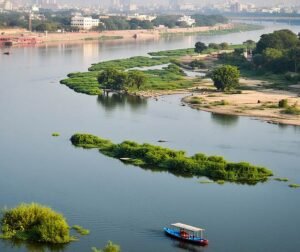
Yamunotri is a renowned pilgrimage site and part of the Chhota Char Dham Yatra. It houses a temple dedicated to Goddess Yamuna, which is highly sacred to Hindus. The temple was originally built in the late 19th century by Maharani Guleria of Jaipur and was reconstructed after natural disasters damaged it in 1923 and 1982.
At Yamunotri, there is a hot water spring called Surya Kund, where pilgrims cook rice and potatoes in cloth bags as an offering. This spring enhances the sanctity of the Yamuna’s origin. The Yamunotri region is accessible for pilgrims and tourists from May to October-November, as heavy snowfall closes the area during winter.
The origin of the Yamuna is surrounded by breathtaking natural beauty, with towering peaks, lush forests, and a serene environment that attracts both devotees and nature lovers. For detailed travel information and online booking for Yamunotri, you can visit the official Yamunotri website.
The Journey of the Yamuna Rivers
The Yamuna River’s 1,376-kilometer journey takes it through diverse landscapes, states, and cities. Its course can be divided into the following stages:
1. Himalayan Region (Uttarakhand and Himachal Pradesh)
The Yamuna begins its journey in the upper Himalayas, flowing south for the first 200 kilometers through the lower Himalayas and the Shivalik Range. In this region, the river’s flow is swift and narrow, with geological features like interlocking spurs, steep cliffs, gorges, and river terraces shaping its path.
The Yamuna’s catchment area in this region spans 2,320 square kilometers, including parts of Himachal Pradesh. Several smaller tributaries, such as the Rishi Ganga, Hanuman Ganga, Bata, and Giri, join the Yamuna here.
At Dakpathar Barrage in Uttarakhand, the Yamuna’s water is diverted into a canal for hydropower generation. The river then passes through the Asan Barrage, where the Asan River merges with it. This barrage is also home to a bird sanctuary, popular among birdwatchers.
The Yamuna flows through Paonta Sahib in Himachal Pradesh, a significant Sikh pilgrimage site, before entering the border region of Haryana and Uttar Pradesh. In this Himalayan stretch, the Yamuna’s water remains clear and blue, untouched by urban pollution.
2. Plains Region (Haryana, Delhi, and Uttar Pradesh)
After exiting the Himalayas, the Yamuna enters the Doon Valley in Uttarakhand and transitions into the plains. It reaches Tajewala (now Hathnikund Barrage) in Haryana’s Yamunanagar district. From this barrage, two major canals—the Western Yamuna Canal and the Eastern Yamuna Canal—divert water for irrigation in Haryana and Uttar Pradesh.
The Yamuna then flows into Delhi, where it serves as the primary source of water for the national capital. Key structures like the Wazirabad Barrage and Okhla Barrage regulate the river’s flow and divert water into canals. Unfortunately, Delhi is where the Yamuna faces severe pollution due to industrial waste, domestic sewage, and other pollutants, rendering its water unfit for drinking or bathing.
After Delhi, the Yamuna flows through several cities in Uttar Pradesh, including Mathura, Agra, Firozabad, Etah, Kalpi, Hamirpur, and finally Prayagraj. Mathura and Agra hold immense religious and cultural significance due to their association with Lord Krishna, the Yamuna being central to his divine pastimes. In Mathura, ghats like Vishram Ghat are sacred pilgrimage sites.
In Agra, the Yamuna flows behind the Taj Mahal, enhancing the monument’s beauty. However, pollution in Agra has also affected the river’s quality, diminishing its natural charm.
3. Triveni Sangam (Prayagraj)
The Yamuna concludes its journey at the Triveni Sangam in Prayagraj, where it merges with the Ganga River and the mythical Saraswati River. This confluence is one of the holiest sites in Hinduism, attracting millions of devotees during the Kumbh Mela, held every 12 years. The sight of the Yamuna’s deep blue water meeting the Ganga’s lighter green water is mesmerizing.
The Triveni Sangam is not only religiously significant but also geographically and culturally important. For more details about the Kumbh Mela, visit the official Kumbh Mela website.
Tributaries of the Yamuna River
The Yamuna River is joined by several tributaries that enhance its flow and expand its catchment area. These tributaries can be categorized into left-bank tributaries and right-bank tributaries.
Left-Bank Tributaries
- Hindon River: Originating in the Rajaji Range in Saharanpur, Uttar Pradesh, this river flows 400 kilometers before joining the Yamuna in Noida’s Sector-150. A rain-fed river, it supports areas like Delhi, Ghaziabad, and Noida but is heavily polluted.
- Hanuman Ganga: A small tributary in Uttarakhand, it merges with the Yamuna and contributes to local water supply.
- Sasur Khaderi River: Flowing through Fatehpur and Kaushambi in Uttar Pradesh, this 40-kilometer-long river joins the Yamuna and supports local agriculture.
Right-Bank Tributaries
- Tons River: The largest and longest tributary of the Yamuna, it originates from the Bandarpunch Glacier in Uttarakhand’s Garhwal region and joins the Yamuna at Kalsi near Dehradun. Spanning 148 kilometers, the Tons carries twice as much water as the Yamuna at their confluence.
- Giri River: Originating in Kotkhai, Himachal Pradesh, it joins the Yamuna at the Himachal Pradesh-Uttarakhand border. It is a key water source for southeastern Himachal Pradesh.
- Chambal River: The longest tributary of the Yamuna, it stretches 1,024 kilometers from its source in the Janapav Hills of the Vindhyachal Range in Madhya Pradesh. Flowing through Madhya Pradesh, Rajasthan, and Uttar Pradesh, it joins the Yamuna near Etawah. The Chambal is famous for the National Chambal Sanctuary, which protects gharials and other wildlife. Learn more at the National Chambal Sanctuary website.
- Betwa River: Originating in the Vindhyachal Hills in Raisen, Madhya Pradesh, this 590-kilometer-long river joins the Yamuna in Hamirpur, Uttar Pradesh. It supports irrigation and drinking water needs in Madhya Pradesh and Uttar Pradesh and is associated with historical sites like Orchha.
- Ken River: Flowing 427 kilometers from the Kaimur Hills in Katni, Madhya Pradesh, it joins the Yamuna in Banda, Uttar Pradesh. Known for its clear waters and scenic beauty, the Ken supports local ecosystems.
- Sindh River: Originating in Sironj, Madhya Pradesh, this 470-kilometer-long river joins the Yamuna in Jalaun, Uttar Pradesh, contributing to irrigation and water supply.
In addition to these major tributaries, numerous smaller streams and drains feed into the Yamuna, contributing to approximately 70% of its total catchment area.
Religious and Cultural Significance of the Yamuna River
The Yamuna holds a special place in Hinduism, where it is worshipped as Goddess Yamuna, the daughter of the Sun God and sister of Yama. Hindu scriptures state that bathing in the Yamuna’s waters cleanses sins and grants liberation from the cycle of birth and death.
Yamuna and Lord Krishna
The Yamuna’s cultural significance is deeply tied to Lord Krishna, as Mathura and Vrindavan—located on its banks—are his birthplace and divine playground. Hindu texts like the Bhagavata Purana describe several of Krishna’s pastimes associated with the Yamuna, including:
- Krishna and Kaliya: In Vrindavan, the serpent Kaliya poisoned the Yamuna’s waters. Lord Krishna subdued Kaliya and purified the river, symbolizing his divine power and the Yamuna’s sanctity.
- Rasleela: Krishna performed the divine Rasleela with the gopis on the Yamuna’s banks, a symbol of devotion and love. The ghats of Vrindavan continue to evoke these divine events.
In Mathura, Vishram Ghat is the most famous ghat, where Krishna is believed to have rested after defeating Kaliya. It remains a key pilgrimage site. For more information about Mathura’s attractions, visit the official Mathura tourism website.
Festivals Associated with the Yamuna
The Yamuna is central to several Hindu festivals, including:
- Yam Dwitiya (Bhai Dooj): Celebrated two days after Diwali, sisters pray for their brothers’ long lives by bathing in the Yamuna, commemorating the bond between Yamuna and Yama.
- Kumbh Mela: Held every 12 years at the Triveni Sangam in Prayagraj, bathing in the Yamuna during the Kumbh Mela is considered highly auspicious.
- Chhath Puja: Popular in Bihar and Uttar Pradesh, this festival involves worshipping the Sun God on the Yamuna’s ghats.
Yamuna and the Taj Mahal
In Agra, the Yamuna flows behind the Taj Mahal, a UNESCO World Heritage Site. The monument’s beauty is enhanced by the river’s serene presence. Built by Mughal Emperor Shah Jahan in memory of his wife Mumtaz Mahal, the Taj Mahal’s location on the Yamuna’s banks was chosen for its scenic appeal. Visit the official Taj Mahal website for more details.
Environmental Challenges Facing the Yamuna River
Once known for its clear, blue waters, the Yamuna is now grappling with severe pollution, particularly in urban areas like Delhi and Agra. Key environmental challenges include:
1. Industrial Pollution
Industrial waste from cities like Delhi and Agra, containing chemicals, heavy metals, and toxins, is discharged into the Yamuna, severely degrading its water quality and harming aquatic life.
2. Domestic Sewage
Delhi releases millions of liters of untreated sewage into the Yamuna daily. Drains and sewage systems dump waste directly into the river, making its water toxic and unsuitable for use.
3. Agricultural Runoff
Chemical fertilizers and pesticides used in agriculture in Haryana and Uttar Pradesh wash into the Yamuna during rains, further polluting its waters.
4. Reduced Water Flow
Barrages and canals, such as Hathnikund and Wazirabad, divert significant amounts of the Yamuna’s water, reducing its natural flow. This affects the river’s ability to self-purify and sustain its ecosystem.
Efforts to Save the Yamuna
Several initiatives are underway to address the Yamuna’s pollution:
- Yamuna Action Plan: A collaborative effort by the Indian and Japanese governments, this program aims to clean the Yamuna by establishing sewage treatment plants (STPs).
- Namami Gange Project: This initiative focuses on cleaning the Ganga and its tributaries, including the Yamuna. Learn more at the Namami Gange website.
- NGO Efforts: Organizations like SWEEP (Save Yamuna Environment Project) work on cleanup drives and awareness campaigns.
Despite these efforts, progress has been slow, and collective action, stricter regulations, and public awareness are needed to restore the Yamuna’s health.
Economic Importance of the Yamuna River
The Yamuna plays a crucial role in northern India’s economy through the following contributions:
1. Agriculture
The Yamuna and its canals irrigate millions of hectares of farmland in Haryana, Uttar Pradesh, and Delhi. The Western and Eastern Yamuna Canals support crops like wheat, rice, and sugarcane.
2. Drinking Water Supply
The Yamuna meets most of the drinking water needs of Delhi and other cities. Water treatment plants like Wazirabad and Chandrawal rely on the Yamuna’s water.
3. Industry
The Yamuna’s water is used in industries such as textiles, leather, and chemicals. However, industrial waste contributes significantly to the river’s pollution.
4. Tourism
Cities like Mathura, Vrindavan, Agra, and Prayagraj, located on the Yamuna’s banks, attract millions of tourists. Sites like the Taj Mahal, Yamunotri, and Triveni Sangam boost local economies.
Biodiversity of the Yamuna River
The Yamuna’s catchment area is rich in biodiversity, supporting a variety of aquatic and terrestrial species. Key species include:
- Aquatic Life: The Yamuna is home to fish species like rohu, catla, and mrigal. The Chambal confluence supports gharials and crocodiles.
- Birds: The Yamuna’s banks and surrounding areas host migratory and resident birds, including Siberian cranes, sarus cranes, and kingfishers. Asan Barrage and Okhla Bird Sanctuary are popular birdwatching sites.
- Vegetation: Plants like lotus, water hyacinth, and grasses grow along the Yamuna’s banks, though pollution threatens many species.
Protected areas like the National Chambal Sanctuary and Okhla Bird Sanctuary help conserve the Yamuna’s biodiversity.
Interesting Facts About the Yamuna River
- Color of the Yamuna: The Yamuna’s water is clear and blue at its source but turns black and polluted in Delhi and Agra.
- Longest Tributary: The Chambal is the Yamuna’s longest tributary, itself a major river.
- Ancient Name: The Yamuna is also referred to as Kalindi in ancient texts.
- Triveni Sangam: The confluence of the Yamuna, Ganga, and Saraswati in Prayagraj is one of the world’s holiest sites.
- Taj Mahal’s Backdrop: The Yamuna enhances the beauty of the Taj Mahal, one of the Seven Wonders of the World.
Conclusion
The Yamuna River is an integral part of India’s cultural, religious, and economic heritage. From its origin at the Yamunotri Glacier to its confluence with the Ganga at the Triveni Sangam, the Yamuna’s 1,376-kilometer journey is a testament to its significance. Its tributaries, such as the Tons, Chambal, and Betwa, expand its reach, while its religious importance is tied to Lord Krishna and sacred Hindu sites. Economically, the Yamuna supports agriculture, industry, and tourism.
However, the Yamuna faces severe pollution, threatening its sanctity and utility. Collective efforts are needed to restore its pristine state. The Yamuna is not just a river but a symbol of India’s natural and cultural legacy, and preserving it is our shared responsibility.
- Godavari River :Origin, Tributaries and Interesting Information
- Amazon River : its origin, course, tributaries, ecosystem, and facts
Through this post, we have explored the Yamuna River’s complete story in a simple and detailed manner. If you have any questions or experiences related to the Yamuna, please share them in the comments. For more information on efforts to clean the Yamuna, visit the Namami Gange website.
